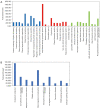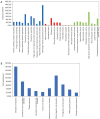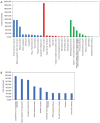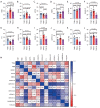Proteomic analysis of plasma exosomes in patients with non-small cell lung cancer
- PMID: 35958340
- PMCID: PMC9359946
- DOI: 10.21037/tlcr-22-467
Proteomic analysis of plasma exosomes in patients with non-small cell lung cancer
Abstract
Background: Currently, the prognosis of patients with non-small cell lung cancer (NSCLC) remains unsatisfactory. This current study evaluated the relationship between histology of NSCLC and protein expression of exosomes in the plasma from NSCLC patients, and furthermore investigate the impact of the exosome profile on the tumor, node, metastasis (TNM) classification.
Methods: Plasma samples were collected from 26 NSCLC patients before surgery. The exosomes were extracted from the plasma and liquid chromatography-mass spectrometry (LC/MS) was used to evaluate the expression of the proteins in the exosomes. Gene Ontology (GO) and Kyoto Encyclopedia of Genes and Genomes (KEGG) enrichment analyses were performed using the Cytoscape 3.8.2 software. Multivariate logistic regression and receiver operating characteristic (ROC) curves were used to identify proteins which could effectively distinguish between lung adenocarcinoma and lung squamous cell carcinoma. The relationship between protein expression and the TNM stage was calculated using Spearman rank correlation.
Results: The expression levels of ZSWIM9, FYB1, SERPINF1, C1orf68, MASP2, and IGHV3-72 were higher in patients with lung adenocarcinoma compared to patients with lung squamous cell carcinoma. MFGE8 was associated with the occurrence of squamous cell carcinoma. CORO1A was positively correlated with the TNM stage of the patients, and COL4A2 was negatively correlated with TNM stage. GO and KEGG analyses revealed that cholesterol metabolism was important in NSCLC development.
Conclusions: Lung adenocarcinoma may be distinguished from squamous cell carcinoma by the molecular profile of exosomes in the plasma samples. And, proteomics analysis suggested that cholesterol metabolism may play an important role of cancer progress in NSCLC.
Keywords: Gene Ontology (GO); Non-small cell lung cancer (NSCLC); differently expressed proteins; exosome; proteomics.
2022 Translational Lung Cancer Research. All rights reserved.
Conflict of interest statement
Conflicts of Interest: All authors have completed the ICMJE uniform disclosure form (available at https://tlcr.amegroups.com/article/view/10.21037/tlcr-22-467/coif). The authors have no conflicts of interest to declare.
Figures









Similar articles
-
Comprehensive analysis of the long noncoding RNA HOXA11-AS gene interaction regulatory network in NSCLC cells.Cancer Cell Int. 2016 Dec 1;16:89. doi: 10.1186/s12935-016-0366-6. eCollection 2016. Cancer Cell Int. 2016. PMID: 27980454 Free PMC article.
-
Expression profiles and clinical value of plasma exosomal Tim-3 and Galectin-9 in non-small cell lung cancer.Biochem Biophys Res Commun. 2018 Apr 6;498(3):409-415. doi: 10.1016/j.bbrc.2018.02.114. Epub 2018 Feb 13. Biochem Biophys Res Commun. 2018. PMID: 29452091
-
The Comparison of Serum Exosome Protein Profile in Diagnosis of NSCLC Patients.Int J Mol Sci. 2023 Sep 5;24(18):13669. doi: 10.3390/ijms241813669. Int J Mol Sci. 2023. PMID: 37761972 Free PMC article.
-
A Novel Hypoxia-Related Gene Signature with Strong Predicting Ability in Non-Small-Cell Lung Cancer Identified by Comprehensive Profiling.Int J Genomics. 2022 May 19;2022:8594658. doi: 10.1155/2022/8594658. eCollection 2022. Int J Genomics. 2022. PMID: 35634481 Free PMC article.
-
Untargeted metabolomics analysis of esophageal squamous cell cancer progression.J Transl Med. 2022 Mar 14;20(1):127. doi: 10.1186/s12967-022-03311-z. J Transl Med. 2022. PMID: 35287685 Free PMC article. Review.
Cited by
-
Comparative proteomic analysis between tumor tissues and intratumoral exosomes from lung adenocarcinoma patients identifies PAFAH1B3 as an exosomal protein key for initiating metastasis in lung adenocarcinoma.Heliyon. 2024 Oct 28;10(21):e39859. doi: 10.1016/j.heliyon.2024.e39859. eCollection 2024 Nov 15. Heliyon. 2024. PMID: 39553628 Free PMC article.
-
AuNPs/CNC Nanocomposite with A "Dual Dispersion" Effect for LDI-TOF MS Analysis of Intact Proteins in NSCLC Serum Exosomes.Adv Sci (Weinh). 2024 Mar;11(12):e2307360. doi: 10.1002/advs.202307360. Epub 2024 Jan 15. Adv Sci (Weinh). 2024. PMID: 38224220 Free PMC article.
-
Identification of tumor heterogeneity associated with KRAS/TP53 co-mutation status in lung adenocarcinoma based on single-cell RNA sequencing.Am J Cancer Res. 2024 Feb 15;14(2):655-678. doi: 10.62347/NXAJ9418. eCollection 2024. Am J Cancer Res. 2024. PMID: 38455404 Free PMC article.
-
Ubiquitination-related biomarkers in metastatic melanoma patients and their roles in tumor microenvironment.Front Oncol. 2023 May 19;13:1170190. doi: 10.3389/fonc.2023.1170190. eCollection 2023. Front Oncol. 2023. PMID: 37274231 Free PMC article.
-
Proteomics analysis of serum from thymoma patients.Sci Rep. 2023 Mar 29;13(1):5117. doi: 10.1038/s41598-023-32339-4. Sci Rep. 2023. PMID: 36991043 Free PMC article.
References
LinkOut - more resources
Full Text Sources
Miscellaneous
